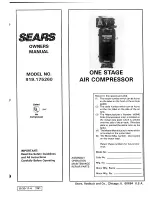
070.610-IOM (JUL 21)
Page 36
RWF II Rotary Screw Compressor Units
Maintenance
Changing oil
WARNING
Do not mix oils of different brands, manufacturers, or
types. Mixing of oils may cause excessive oil foaming,
nuisance oil level cutouts, oil pressure loss, gas or oil
leakage and catastrophic compressor failure.
Shut down
the unit when changing oil. At the same time
all
oil filter cartridges must be changed and all
oil strainer
elements removed and cleaned. The procedure is as fol-
lows:
1.
Press the
[STOP]
key on the microprocessor panel to
stop the compressor unit.
2.
Open the disconnect switch for the compressor motor
starter.
3.
Close the suction and discharge service valves; also
close the liquid-injection and economizer service valves, if
applicable.
4.
Slowly
vent separator to low-side system pressure us-
ing the bypass line on the suction
trap.
NOTICE
Recover or transfer all refrigerant vapor, in ac-
cordance with local ordinances, before opening to
atmosphere. The separator must be equalized to
atmospheric pressure.
WARNING
Oil-entrained refrigerant may vaporize, causing a
separator pressure increase. Repeat venting and re-
covery procedure, if necessary.
5.
Open the drain valve(s) located on the underside of the
separator and drain the oil.
6.
Drain the oil filter(s) OF-1 and, if ap plicable, the oil
coolers and filter OF-2.
7.
Remove the old filter cartridges, then install new ones
(as previously described in the section
oil filter (
OF-1)
main single/dual)
.
8.
Remove, clean, and reinstall strainer elements in the
strainers.
9.
Evacuate unit to 29.88 in. Hg (1000 microns) vacuum.
10.
Open the suction service valve and pressurize the unit
to system suction pressure. Close the suction valve and leak
test.
11.
Add oil by attaching a suitable pressure-type hose to
the
oil drain valve located under the separator. Using a
pressure-type oil pump and recommended Frick oil, open
the drain valve and fill the separator until the oil level is
midway in the top
sight glass.
NOTICE
Evacuation of the oil separator will assist the flow of
oil into the unit. Also, fill slowly because oil will fill
up in the separator faster than it shows in the sight
glass.
Refer to the table in the
oil charge
section for approxi-
mate oil charge quantities.
12.
Open the suction and discharge service valves, and
also the liquid injection and economizer service valves, if
applicable.
13.
Close the disconnect switch for compressor motor
starter.
14.
Start the unit.
Demand pump disassembly
DANGER
Before opening any viking pump liquid chamber
(pumping chamber, reservoir, jacket, etc.) Ensure:
1. That any pressure in the chamber has been com-
pletely vented through suction or discharge lines or
other appropriate openings or connections.
2. That the driving means (motor, turbine, engine,
etc.) has been locked out, or made non- operational
so that it cannot be started while work is being done
on the pump.
Failure to follow above listed precautionary measures
may result in serious injury or death.
1.
Mark
head and casing before disassembly to ensure
proper reassembly. The idler pin, which is offset in the
pump head, must be positioned up and equal distance
between port connections to allow for proper flow of liquid
through the pump.
2.
Remove the head capscrews.
3.
Tilt top of head back when removing to prevent idler
from falling off idler pin.
4.
Remove idler and bushing assembly. If idler bushing
needs replacing, see
Installing carbon graphite bushings
.
5.
Insert a brass bar or piece of hardwood in the port
opening and betw
een rotor teeth to keep shaft from
turning. Turn the locknut counterclockwise and remove
locknut. See
the following Figure.
Figure 41: Thrust-bearing assembly (GG, HJ, HL)
















































